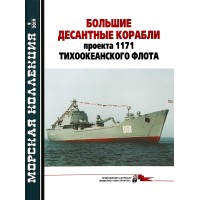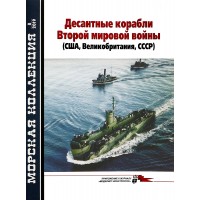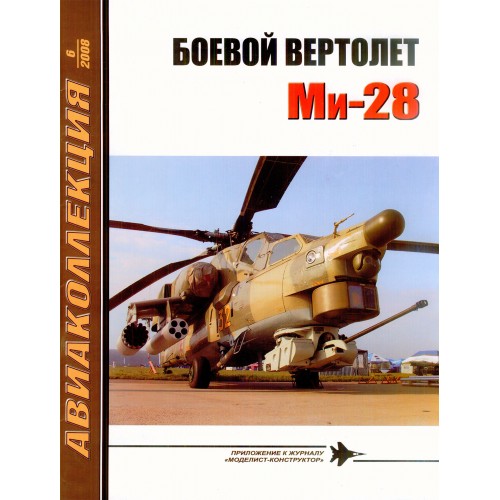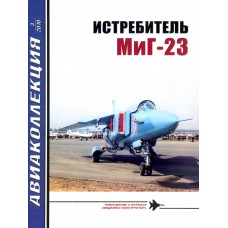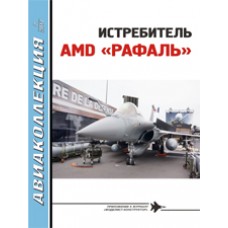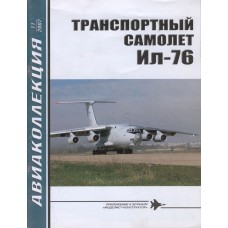AKL-200806 AviaCollection / AviaKollektsia 06/2008: Mil Mi-28 Russian Attack Helicopter. Photos, schemes, colour pictures. 32 pages, soft cover, text in Russian.
HELICOPTER CREATION
The real possibility of creating a combat helicopter in the Soviet Union appeared after the construction of the Mi-4, which lifted up to 1670 kg of cargo. But in the mid-1950s. frontline aviation continued to exist in the country, armed with Il-10 and Il-10M attack aircraft. The need for a combat helicopter has not yet been felt by the military.
The situation changed in the 1960s, when the Mi-8 helicopters with gas turbine engines appeared and the question arose: what to do with the morally and physically obsolete Mi-4A? Then there was a proposal to convert them into helicopters to support ground forces. Having retained the machine-gun mount under the fuselage, on the sides of the vehicle were placed the suspension units of the S-5 unguided aircraft missiles in the UB-16-58UM blocks and the Falanga anti-tank missile launchers with a radio command guidance system.
After the successful completion of state tests of the armed modification of the Mi-4AV in 1967, by decision of the Commission of the Presidium of the Council of Ministers of the USSR on military-industrial issues, 60 vehicles were converted into a combat version. The experiment was a success, and a year later the government ordered the industry to produce sets of equipment for the revision of another 140 transport helicopters into combat ones.
The Mi-4AV was a purely strike vehicle, since its carrying capacity did not allow transporting troops and weapons at the same time.
The first experience of operation and "combat use" of the Mi-4AV at training ranges led to the emergence of the Mi-24, conceived as a flying infantry fighting vehicle combining transport and strike functions. He carried powerful weapons, but at the same time had a capacious fuselage, allowing to transport a squad of paratroopers. In this helicopter, the designers of the Moscow Helicopter Plant (MVZ) named after M.L. Mile pioneered many innovations, such as retractable landing gear and seating crew members one behind the other.
Export version of the Mi-24 - Mi-35M2 of the Venezuelan Air Force, July 2007
The Mi-24 acquired a full-fledged fuselage - previously, on all MVZ machines, the tail rotor was located on a thin tail boom. However, the name of this component in the technological division of the corpus remained unchanged. The cockpit, as well as the most important components and assemblies of the helicopter, were protected by armor.
But, as shown by the use of the Mi-24 during the war in Afghanistan, the concept of a flying infantry fighting vehicle turned out to be not entirely successful, since the attack helicopter must solve its tasks, and the transport-assault helicopter - its own.
But they did not completely abandon the idea itself, and in 1984 the specialists of the cost center proposed a project for a similar Mi-40 machine in the hope that potential customers would be interested in it. But this did not happen, the military preferred the alternative Mi-42 project, which also combined strike and landing functions, but differed in a reactive control system instead of a tail rotor similar to the foreign NOTAR system.
They returned to the Mi-40 project in 1992. This time the power plant, the main rotor and the tail rotor were completely borrowed from the new Mi-28 combat helicopter. For round-the-clock use in adverse weather conditions, an overhead radar was provided. Since then, "a lot of water has flown under the bridge", but it is not known whether the military will again turn their eyes to the "flying infantry fighting vehicle" in the future.
The Mi-24 has not yet surrendered its positions. This machine will remain in service for a long time, and therefore is constantly being modernized. Its last modification was the cannon Mi-24PN. It is designed to destroy enemy armored vehicles, provide fire support for ground forces, land troops, evacuate the wounded, transport goods, including on an external sling, and is designed for round-the-clock use in limited-adverse weather conditions. To solve these problems, the vehicle, in addition to all kinds of ammunition, is equipped with a night surveillance-sighting subsystem with an infrared direction finder and a laser rangefinder, a satellite navigation system, night vision goggles, etc. A similar Mi-35PN helicopter is intended for foreign customers. Despite the saturation of the Mi-24PN and Mi-35PN with the latest electronic equipment and weapons,
But a specialized apparatus will always do its job better than a universal one - there is no need to make compromise decisions in it. The time has come for a real combat helicopter focused on the most effective use of airborne weapons.
The military chose a two-seater rotary-wing aircraft capable of solving combat missions without caring about their "passengers". Such a helicopter was thought about back in the late 1960s. When the government decree on the creation of the Mi-24 was being prepared, a record appeared in the same document about the development of a rotary-wing attack aircraft on its basis without the possibility of transporting paratroopers. It had to differ from the "flying infantry fighting vehicle" by a higher flight speed. An additional incentive here was the appearance of the American AN-56 Cheyenne rotorcraft with a pushing tail rotor, widely advertised in the foreign press. Thus, the countdown of the "biography" of the future Mi-28 can begin in May 1968, when the above-mentioned resolution was issued.
The development of a new helicopter "Product 280", later renamed Mi-28, began soon after M.L. Mil in 1970, when M.N. Tishchenko. By that time, the American AN-1 Cobra had become the most popular combat helicopter abroad, the firepower of which, despite half the flight weight, was much greater.
The AN-1 was a "clean" strike vehicle, a "flying gunboat". He could not carry either people or cargo, providing only fire impact on the enemy. True, "Cobra" was created rather hastily and had many shortcomings. The USA took into account the experience of its combat use and began to develop the next generation RAH-66 Comanche helicopter.
When designing "product 280", the cost center specialists considered the possibility of using not only the classic layout, but also worked out a variant of a twin-screw helicopter of the transverse scheme. In the latter, under a wing of a large span, it was possible to place almost any type of weapon, of course, within the carrying capacity. In addition, the lift of the wing facilitated the takeoff of an overloaded vehicle with a takeoff run, giving certain advantages over a helicopter of a classical layout. Another advantage is characteristic of the transverse scheme: it allows the crew members to eject without falling into the area of rotation of the rotors, which the military insisted on.
AKL-200806 AviaKollektsia N6 2008: Mil Mi-28 Russian Attack Helicopter magazine
- Brand: AviaCollection / AviaKollektsia
- Product Code: AKL-200806 In Stock
-
$3.90
Available Options
Look at these products too:
AKL-201702 AviaCollection 2017/2 Dassault Rafale French Multirole Fighter
Photos, schemes, colour pictures. 32 pages, soft cover, text in Russian...
$3.90




